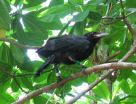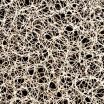(Press-News.org) Researchers from the University of Washington say the Mariana crow, a forest crow living on Rota Island in the western Pacific Ocean, will go extinct in 75 years.
The extinction could happen almost twice as soon as previously believed.
The crow's extinction can be prevented with a bird management program that focuses on helping fledgling birds reach their first birthday, said James Ha, UW research associate professor in psychology.
Ha examined survival rates in 97 Mariana crows – Corvus kubaryi – that had been tracked between 1990 and 2010 by researchers. He found that 40 percent of fledgling crows made it to their first birthday.
The rapid decline of young birds is twice what researchers previously estimated.
"It's the first year of survival that's the most crucial," said Ha, lead author of a report on the research. "If only 40 percent of fledglings survive their first year, then we predict the species will go extinct in 75 years."
Ha and his co-authors published the report in the current issue of Bird Conservation International.
The 75-year extinction estimate is according to a population model that factors in the estimated number of existing Mariana crows – 330 – with the 40 percent first-year survival rate, average number of fledglings per nest and fertility of female birds. Using this model, Ha found that 91 birds would exist in 20 years and that in 75 years the species would be extinct.
Previously, biologists believed that the first-year survival rate of Mariana crows was higher, around 60 to 80 percent.
When Ha used those estimates in his population model, the outlook was not as grim for the birds. At 60 percent first-year survival rate, Mariana crows would dwindle to 218 birds in 20 years and become extinct in 133 years. And an 80 percent first-year survival rate projects that in 20 years there would be 453 birds, a growing population that would avoid extinction.
"According to the population model, if we can boost fledgling survival from 40 percent to 70 percent, the Mariana crows will be fine," Ha said.
Of the about 35 crow species, Mariana crows are considered rare and classified as critically endangered. Weighing about a half of a pound, Mariana crows are 40 percent smaller than other crows, such as the Northwest crow.
Monogamously-mating, Mariana crows live exclusively on Rota Island, populated by about 1,200 people and located 56 miles northeast of Guam. Rota is a U.S. territory and is up for consideration as a U.S. national park.
Ha and Renee Ha, co-author of the report and UW research scientist in psychology, fear that Rota faces the same avian demise as Guam, which has no forest birds.
Brown tree snakes introduced to the island after World War II wiped out native birds, such as the Guam flycatcher and the Rufous fantail.
The Has suspect that the uncontrolled increase of feral cats on Rota is leading to the decrease of Mariana crows, much like brown tree snakes led to the disappearance of forest birds on Guam.
The researchers say that a captive rearing program could save the Mariana crows. They hope to set up a rearing facility where they could incubate eggs from the wild, raise the fledglings until their first birthday and then release the grown birds into nesting sites on the island.
INFORMATION:
The study was funded by the Commonwealth of the Northern Mariana Islands and the U.S. Fish and Wildlife Service. Co-author Alyssa Butler graduated from UW with a bachelor's degree in biology and is now a staff member at the Pali Institute, a science education camp in California.
Learn more about UW's Rota Avian Behavioral Ecology Program: http://depts.washington.edu/rabep/index.html
For more information, contact James Ha at 206-543-2420 or jcha@uw.edu or Renee Ha at 206-685-2380 or robinet@uw.edu.
Without intervention, Mariana crow to become extinct in 75 years
2010-12-21
ELSE PRESS RELEASES FROM THIS DATE:
Finnish researchers find a compound that prevents the growth of prostate cancer cells
2010-12-21
Evidence pointing to the effects of monensin emerged in a project investigating the effects of nearly 5,000 drugs and micromolecules on the growth of prostate cancer cells. The project involved most of the drugs on the market today. Researchers found that small amounts of compounds – disulfiram (Antabus), thiram, tricostatin A, and monensin – can prevent the growth of prostate cancer cells without significant effects on the growth of the normal human prostate epithelial cells.
Further studies revealed that monensin caused prostate cancer cell death by reducing the amount ...
Subsidies have no effect on Spanish cinema productivity
2010-12-21
Awards have an impact on Spanish movie productivity, since they increase internal and external distribution demand, but subsidies have no effect whatsoever on the productivity of the Spanish film industry. This is the conclusion of researchers at the University of Granada (UGR), who have studied the production of films in Spain.
"Awards increase the amount of films produced by increasing productivity. In other words film industry workers and companies are more productive and efficient. However, we did not detect that subsidies had any such effect on productivity", Henry ...
A possible cause -- and cure -- for genital cancer in horses?
2010-12-21
Horses are prone to develop genital cancer, especially as they grow older. Male horses are more commonly affected than mares but both sexes suffer from the condition, which is extremely difficult to treat and may result in the animals' death. Because of the similarity of the disease to human genital cancer it seemed possible that a similar agent might be responsible. Several human genital cancers, including cervical tumours, are known to be caused by a papillomavirus infection, so Brandt and her coworkers used genetic techniques to look for papillomavirus DNA in tissue ...
Study finds food in early life affects fertility
2010-12-21
The reproductive success of men and women is influenced by the food they receive at an early stage in life, according to new research by the University of Sheffield.
The research, which was published online this month (17 December 2010) in the journal Ecology, is the first study of its kind to show that early life food can have a serious influence on the life-long fertility of individuals.
The research team, led by Dr Ian Rickard from the Department of Animal and Plant Sciences at the University, used a combination of church record data on births in 18th century Finland ...
Muscle filaments make mechanical strain visible
2010-12-21
Plastics-based materials have been in use for decades. But manufacturers are facing a serious hurdle in their quest for new developments: Substantial influences of the microscopic material structure on mechanical material properties cannot be observed directly. The synthetic polymer molecules are simply too small for microscopic observation in mechanical experiments. A team of physicists led by professor Andreas Bausch of the Technische Universitaet Muenchen (TUM) has now developed a method that allows just these kinds of measurements. They present their results in Nature ...
When the zebra loses its stripes
2010-12-21
Milan, Italy, 20 December 2010 – The capacity to remember that a zebra has stripes, or that a giraffe is a four-legged mammal, is known as semantic memory. It allows us to assign meaning to words and to recall general knowledge and concepts that we have learned. The deterioration of these capacities is a defining feature of semantic dementia and can also occur in Alzheimer's disease. A group of French neurologists and neuropsychologists have now identified the elements of semantic memory which are the first to deteriorate and may have thus explained why a surprising phenomenon ...
Genome-wide hunt reveals links to abnormal rhythms behind sudden death, heart damage
2010-12-21
A study among almost 50,000 people worldwide has identified DNA sequence variations linked with the heart's electrical rhythm in several surprising regions among 22 locations across the human genome. The variants were found by an international consortium, including Johns Hopkins researchers, and reported Nov. 14 in the Nature Genetics advance online publication.
Among the notable discoveries were variations in two side-by-side genes that regulate electrically charged particles to produce signals that start contraction of the heart and register as pulsing waves seen on ...
Johns Hopkins faculty highly value involvement of nearby urban community for improving research
2010-12-21
A survey conducted by Johns Hopkins faculty found strong support among their peers for working more closely with the minority, inner-city community that surrounds the institution. Overall, 91 percent of faculty responders said closer ties make research more relevant to those it ultimately serves, and 87 percent said it improves the quality of research.
"This is a huge, stunning finding," says Nancy Kass, Sc.D., deputy director for public health at the Johns Hopkins Berman Institute of Bioethics. "Faculty are giving a ringing endorsement of how important working with ...
New software detects piping flaws
2010-12-21
New software developed by the U.S. Department of Energy's Savannah River National Laboratory (SRNL) and Northrop Grumman Shipbuilding (NGSB) may lead to a less expensive and less time consuming method to detect corrosion or other defects in a ship's pipes.
The copyrighted software, which is used to analyze digitized x-ray images to determine loss of wall thickness in pipes, was developed as the result of a six-month cooperative research and development agreement between SRNL and NGSB. SRNL has granted NGSB a license to commercialize and continue maturing the software ...
Reducing emissions from shipping: Commission's Joint Research Centre sets out some options
2010-12-21
Maritime transport causes about 4% of global man-made CO2 emissions which makes its carbon footprint approximately as high as Germany's. There is no regulation of international maritime transport emissions yet, but this is currently under discussion in the International Maritime Organization (IMO) and at the United Nations Framework Convention on Climate Change (UNFCCC). In respect of greenhouse gas (GHG) emissions, shipping is the most environmentally-friendly mode of transport. However, if no action is taken, it is estimated that emissions from ships will increase by ...


